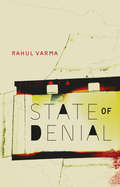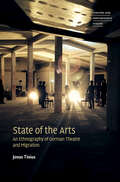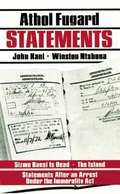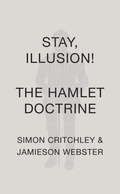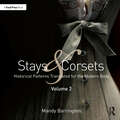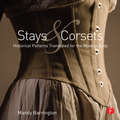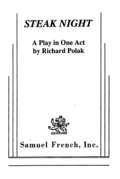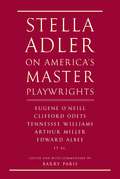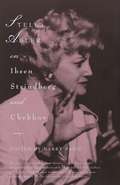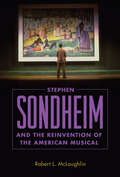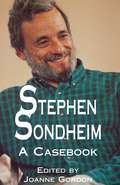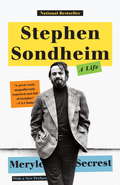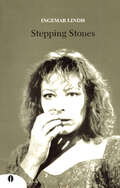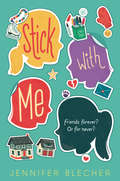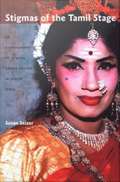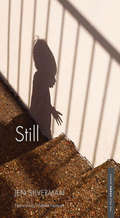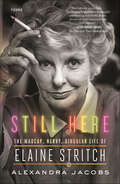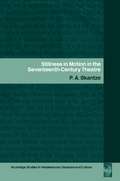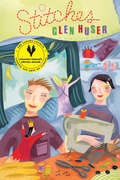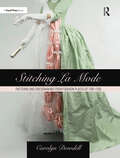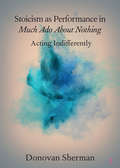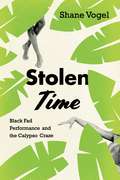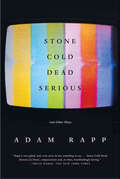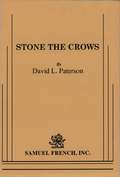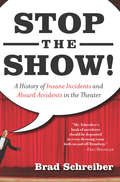- Table View
- List View
State of Denial
by Rahul VarmaOdette is a young Rwandan-born Canadian filmmaker who has travelled to Turkey to investigate stories of genocide and hidden identity for an upcoming film. When she interviews Sahana, an elderly Muslim woman who has spent her life assisting survivors of the Armenian genocide, she learns a devastating secret about Sahana, one that she resolves to share with the world at any cost, even if it means revealing her own shocking secret.
State of the Arts: An Ethnography of German Theatre and Migration (Theatre and Performance Theory)
by Jonas TiniusThis is a bold and wide-ranging account of the unique German public theatre system through the prism of a migrant artistic institution in the western post-industrial Ruhr region. State of the Arts analyses how artistic traditions have responded to social change, racism, and cosmopolitan anxieties and recounts how critical contemporary cultural production positions itself in relation to the tumultuous history of German state patronage, difficult heritage, and self-cultivation through the arts. Jonas Tinius' fieldwork with professional actors, directors, cultural policy makers, and activists unravels how they constitute theatre as a site for extra-ordinary ethical conduct and how they grapple with the pervasive German cultural tradition of Bildung, or self-cultivation through the arts. Tinius shows how anthropological methods provide a way to understand the entanglement of cultural policy, institution-building, and subject-formation. An ambitious and interdisciplinary study, the work demonstrates the crucial role of artistic intellectuals in society.
Statements
by Athol Fugard Winston Ntshona John KaniDeveloped in workshops with award-winning actors, these are the works in Fugard's canon that most directly confront the dehumanizing brutality of apartheid. Includes: Sizwe Bansi is Dead, The Island, and Statements After an Arrest Under the Immorality Act.
Stay, Illusion!
by Simon Critchley Jamieson WebsterThe figure of Hamlet haunts our culture like the ghost haunts Shakespeare's melancholy Dane. Arguably, no literary work is more familiar to us. Everyone knows at least six words from Hamlet, and most people know many more. Yet the play--Shakespeare's longest--is more than "passing strange," and it becomes even more complex when considered closely. Reading Hamlet alongside other writers, philosophers, and psychoanalysts--Carl Schmitt, Walter Benjamin, Freud, Lacan, Nietzsche, Melville, and Joyce--Simon Critchley and Jamieson Webster go in search of a particularly modern drama that is as much about ourselves as it is a product of Shakespeare's imagination. They also offer a startling interpretation of the action onstage: it is structured around "nothing"--or, in the enigmatic words of the player queen, "it nothing must." From the illusion of theater and the spectacle of statecraft to the psychological interplay of inhibition and emotion, Hamlet discloses the modern paradox of our lives: how thought and action seem to pull against each other, the one annulling the possibility of the other. As a counterweight to Hamlet's melancholy paralysis, Ophelia emerges as the play's true hero. In her madness, she lives the love of which Hamlet is incapable. Avoiding the customary clichés about the timelessness of the Bard, Critchley and Webster show the timely power of Hamlet to cast light on the intractable dilemmas of human existence in a world that is rotten and out of joint.
Stays and Corsets Volume 2: Historical Patterns Translated for the Modern Body
by Mandy BarringtonIn this second volume of Stays and Corsets, Mandy Barrington continues to create historical patterns for a modern body shape. This book contains all new corset patterns with a range of silhouettes that span over 300 years, from the late 16th century to the early 20th century. The corset patterns are generated from an original historical garment and have been designed for a wide range of female figures and sizes. The technique of flat pattern drafting your stays or corset will enable you to change the shape of the wearer to create an authentic historic silhouette. All calculations have been worked out for the reader and are provided in easy-to-read tables, which avoids extremely difficult, time-consuming and inaccurate re-sizing of historical patterns. Some prior knowledge of pattern drafting is helpful; however, each pattern has step-by-step instructions supported by clear diagrams that will take you through each stage of the pattern drafting process. The final result is an accurate period stays or corset pattern for your model.
Stays and Corsets: Historical Patterns Translated for the Modern Body
by Mandy BarringtonStays and Corsets: Historical Patterns Translated for the Modern Body goes a step beyond traditional historical costuming texts by not only providing you with historical pattern diagrams and information, but by showing you how to adapt these patterns to the contemporary body shape. Using her original pattern-drafting system, author Mandy Barrington will show you how to draft a historical pattern for a modern body shape, while still retaining an accurate historical silhouette. Each pattern has been generated from an original stay, corset, or pattern taken from a historical garment. The instructions to follow these new patterns are designed to accommodate any size of female figure, allowing you to avoid extremely difficult, time consuming, and inaccurate historical pattern re-sizing Requiring only basic prior knowledge of pattern drafting, all calculations have been worked out for the costume maker and are provided in simple tables accompanied by easy-to-read, step-by-step diagrams that clearly show how the historical pattern is plotted onto the female basic block, coupled with photographs of the constructed stays and corsets.
Steak Night
by Richard PolakComedy / 3m, 2f / Interior / This is an amusing yet chilling look at an American family which is doing something about declining family values. They have a strict set of rules and, if one is broken, the other family members vote on the nature, length and severity of punishment. The voting always takes place on the night the family has steak for dinner. The most enthusiastic participant in this rite is Alan, a 16 year old bully, until he transgresses and the family votes on his punishment. Very cleverly, very deviously, Alan swings the vote in his favor and takes over the family!
Stella Adler on America's Master Playwrights: Eugene O'Neill, Thornton Wilder, Clifford Odets, William Saroyan, Tennessee Williams, William Inge, Arthur Miller, Edward Albee
by Stella AdlerIn her long-awaited book, the legendary acting teacher Stella Adler gives us her extraordinary insights into the work of Henrik Ibsen ("The creation of the modern theater took a genius like Ibsen . . . Miller and Odets, Inge and O'Neill, Williams and Shaw, swallowed the whole of him"), August Strindberg ("He understood and predicted the forces that would break in our lives"), and Anton Chekhov ("Chekhov doesn't want a play, he wants what happened in life. In life, people don't usually kill each other. They talk"). Through the plays of these masters, Adler discusses the arts of playwriting and script interpretation ("There are two aspects of the theater. One belongs to the author and the other to the actor. The actor thinks it all belongs to the author . . . The curtain goes up and all he knows are the lines . . . It is not enough . . . Script interpretation is your profession"). She looks into aspects of society and class, and into our cultural past, as well as the evolution of the modern spirit ("The actor learns from Ibsen what is modern in the modern theater. There are no villains, no heroes. Ibsen understands, more than anything, there is more than one truth"). Stella Adler--daughter of Jacob Adler, who was universally acknowledged to be the greatest actor of the Yiddish theater, and herself a disciple of Stanislavsky--examines the role of the actor and brings to life the plays from which all modern theater derives: Ibsen's Hedda Gabler, The Master Builder, An Enemy of the People, and A Doll's House; Strindberg's Miss Julie and The Father; Chekhov's The Seagull, Uncle Vanya, The Cherry Orchard, and Three Sisters ("Masha is the sister who is the mystery. You cannot reach her. You cannot reach the artist. There is no logical way. Keep her in a special pocket of feelings that are complex and different"). Adler discusses the ideas behind these plays and explores the world of the playwrights and the history--both familial and cultural--that informed their work. She illumines not only the dramatic essence of each play but its subtext as well, continually asking questions that deepen one's understanding of the work and of the human spirit. Adler's book, brilliantly edited by Barry Paris, puts her famous lectures into print for the first time.
Stella Adler on Ibsen, Strindberg, and Chekhov
by Barry Paris Stella AdlerIn her long-awaited book, the legendary acting teacher Stella Adler gives us her extraordinary insights into the work of Henrik Ibsen ("The creation of the modern theater took a genius like Ibsen. . .Miller and Odets, Inge and O'Neill, Williams and Shaw, swallowed the whole of him"), August Strindberg ("He understood and predicted the forces that would break in our lives"), and Anton Chekhov ("Chekhov doesn't want a play, he wants what happens in life. In life, people don't usually kill each other. They talk").Through the plays of these masters, Adler discusses the arts of playwriting and script interpretation ("There are two aspects of the theater. One belongs to the author and the other to the actor. The actor thinks it all belongs to the author. . .The curtain goes up and all he knows are the lines. . .It is not enough. . .Script interpretation is your profession").She looks into aspects of society and class, and into our cultural past, as well as the evolution of the modern spirit ("The actor learns from Ibsen what is modern in the modern theater. There are no villains, no heroes. Ibsen understands, more than anything, there is more than one truth").Stella Adler--daughter of Jacob Adler, who was universally acknowledged to be the greatest actor of the Yiddish theater, and herself a disciple of Stanislavsky--examines the role of the actor and brings to life the plays from which all modern theater derives: Ibsen's Hedda Gabler, The Master Builder, An Enemy of the People, and A Doll's House; Strindberg's Miss Julie and The Father; Chekhov's The Seagull, Uncle Vanya, The Cherry Orchard, and Three Sisters ("Masha is the sister who is the mystery. You cannot reach her. You cannot reach the artist. There is no logical way. Keep her in a special pocket of feelings that are complex and different"). Adler discusses the ideas behind these plays and explores the world of the playwrights and the history--both familial and cultural--that informed their work. She illumines not only the dramatic essence of each play but its subtext as well, continually asking questions that deepen one's understanding of the work and of the human spirit. Adler's book, brilliantly edited by Barry Paris, puts her famous lectures into print for the first time.From the Hardcover edition.
Stephen Sondheim and the Reinvention of the American Musical
by Robert L. McLaughlinFrom West Side Story in 1957 to Road Show in 2008, the musicals of Stephen Sondheim (1930–2021) and his collaborators have challenged the conventions of American musical theater and expanded the possibilities of what musical plays can do, how they work, and what they mean. Sondheim's brilliant array of work, including such musicals as Company, Follies, Sweeney Todd, Sunday in the Park with George, and Into the Woods, established him as the preeminent composer/lyricist of his, if not all, time. Stephen Sondheim and the Reinvention of the American Musical places Sondheim's work in two contexts: the exhaustion of the musical play and the postmodernism that, by the 1960s, deeply influenced all the American arts. Sondheim's musicals are central to the transition from the Rodgers and Hammerstein-style musical that had dominated Broadway stages for twenty years to a new postmodern musical. This new style reclaimed many of the self-aware, performative techniques of the 1930s musical comedy to develop its themes of the breakdown of narrative knowledge and the fragmentation of identity. In his most recent work, Sondheim, who was famously mentored by Oscar Hammerstein II, stretches toward a twenty-first-century musical that seeks to break out of the self-referring web of language. Stephen Sondheim and the Reinvention of the American Musical offers close readings of all of Sondheim's musicals and finds in them critiques of the operation of power, questioning of conventional systems of knowledge, and explorations of contemporary identity.
Stephen Sondheim: A Casebook (Casebooks on Modern Dramatists #Vol. 23)
by Joanne GordonFirst Published in 1997. Routledge is an imprint of Taylor & Francis, an informa company.
Stephen Sondheim: A Life
by Meryle SecrestIn the first full-scale life of the most important composer-lyricist at work in musical theatre today, Meryle Secrest, the biographer of Frank Lloyd Wright and Leonard Bernstein, draws on her extended conversations with Stephen Sondheim as well as on her interviews with his friends, family, collaborators, and lovers to bring us not only the artist--as a master of modernist compositional style--but also the private man. Beginning with his early childhood on New York's prosperous Upper West Side, Secrest describes how Sondheim was taught to play the piano by his father, a successful dress manufacturer and amateur musician. She writes about Sondheim's early ambition to become a concert pianist, about the effect on him of his parents' divorce when he was ten, about his years in military and private schools. She writes about his feelings of loneliness and abandonment, about the refuge he found in the home of Oscar and Dorothy Hammerstein, and his determination to become just like Oscar.Secrest describes the years when Sondheim was struggling to gain a foothold in the theatre, his attempts at scriptwriting (in his early twenties in Rome on the set of Beat the Devil with Bogart and Huston, and later in Hollywood as a co-writer with George Oppenheimer for the TV series Topper), living the Hollywood life.Here is Sondheim's ascent to the peaks of the Broadway musical, from his chance meeting with play-wright Arthur Laurents, which led to his first success--as co-lyricist with Leonard Bernstein on West Side Story--to his collaboration with Laurents on Gypsy, to his first full Broadway score, A Funny Thing Happened on the Way to the Forum. And Secrest writes about his first big success as composer, lyricist, writer in the 1960s with Company, an innovative and sophisticated musical that examined marriage à la mode. It was the start of an almost-twenty-year collaboration with producer and director Hal Prince that resulted in such shows as Follies, Pacific Overtures, Sweeney Todd, and A Little Night Music.We see Sondheim at work with composers, producers, directors, co-writers, actors, the greats of his time and ours, among them Leonard Bernstein, Ethel Merman, Richard Rodgers, Oscar Hammerstein, Jerome Robbins, Zero Mostel, Bernadette Peters, and Lee Remick (with whom it was said he was in love, and she with him), as Secrest vividly re-creates the energy, the passion, the despair, the excitement, the genius, that went into the making of show after Sondheim show.A biography that is sure to become the standard work on Sondheim's life and art.
Stepping Stones (Routledge Icarus Ser.)
by Ingemar LindhStepping Stones is the book of a practitioner. It documents the work of a laboratory-based practice that investigated the principles of collective improvisation as a performance practice.
Stick With Me
by Jennifer BlecherAn ice skater without a rink. An artist without a place to draw. Two misfit girls who become unlikely friends over the course of an unusual week. Readers of Lynda Mullaly Hunt, Rebecca Stead, and Lisa Graff will adore Stick with Me.Izzy’s best friend seems to be ditching her for the Queen of Mean, Daphne Toll. Izzy wants to fit in and have some real friends, but all she really has are her drawings. And then her family rents out their house during winter break for some extra cash—and that family’s daughter is sleeping in Izzy’s room and attending the same camp!Wren is focused on perfecting her ice-skating routine after tanking at sectionals last year. But when her sister qualifies for a life-changing treatment for her epilepsy, Wren is carted off to stay in a rented home near Boston. It doesn’t help that she’s forced to attend the local theater camp, where it seems like the mean girls have it out for her.Will Izzy and Wren’s shared status as targets of Phoebe and Daphne bring them closer? Or will middle school drama prevent them from ever becoming friends?Jennifer Blecher, the author of the acclaimed Out of Place, writes with a pitch-perfect ear for tween girls about the ups and downs of middle school friendships. Told from dual perspectives, Stick with Me is a story about fitting in and figuring yourself out.
Stigmas of the Tamil Stage: An Ethnography of Special Drama Artists in South India
by Susan SeizerA study of the lives of popular theater artists, Stigmas of the Tamil Stage is the first in-depth analysis of Special Drama, a genre of performance unique to the southernmost Indian state of Tamilnadu. Held in towns and villages throughout the region, Special Drama performances last from 10 p. m. until dawn. There are no theatrical troupes in Special Drama; individual artists are contracted "specially" for each event. The first two hours of each performance are filled with the kind of bawdy, improvisational comedy that is the primary focus of this study; the remaining hours present more markedly staid dramatic treatments of myth and history. Special Drama artists themselves are of all ages, castes, and ethnic and religious affiliations; the one common denominator in their lives is their lower-class status. Artists regularly speak of how poverty compelled their entrance into the field. Special Drama is looked down upon by the middle- and upper-classes as too popular, too vulgar, and too "mixed. " The artists are stigmatized: people insult them in public and landlords refuse to rent to them. Stigma falls most heavily, however, on actresses, who are marked as "public women" by their participation in Special Drama. As Susan Seizer's sensitive study shows, one of the primary ways the performers deal with such stigma is through humor and linguistic play. Their comedic performances in particular directly address questions of class, culture, and gender deviations--the very issues that so stigmatize them. Seizer draws on extensive interviews with performers, sponsors, audience members, and drama agents as well as on careful readings of live Special Drama performances in considering the complexities of performers' lives both on stage and off.
Still
by Marsha Norman Jen SilvermanIn this darkly comic exploration of loss, intimacy, and motherhood, three women are joined by a baby who never lived. Morgan, in her middle years, is the grieving mother of a stillborn child. Elena, the failed midwife, burdened by guilt, is considering a career change. Dolores, eighteen, is pregnant with a baby she does not want. Meanwhile, Constantinople, the child who wasn't meant to be, wanders lost in search of his mother, trying to make sense of the world while making an unlikely appearance in each woman's personal drama. Poignant, lyrical, ingeniously absurd, and outrageously funny, Jen Silverman's Still is a brave and remarkable exploration of grief and family. It is the seventh winner of the DC Horn Foundation/Yale Drama Series Prize, selected this year by Marsha Norman, the Pulitzer Prize-winning author of Getting Out; 'night, Mother; and other acclaimed theatrical works.
Still Here: The Madcap, Nervy, Singular Life of Elaine Stritch
by Alexandra JacobsA New Yorker Favorite Nonfiction Book of the Year: A “genuinely irresistible” biography of Broadway legend Elaine Stritch (Buffalo News).A New York Times Book Review Editors’ ChoiceStill Here is the first full telling of Elaine Stritch’s life. Rollicking but intimate, it tracks one of Broadway’s great personalities from her upbringing in Detroit during the Great Depression to her fateful move to New York City, where she studied alongside Marlon Brando, Bea Arthur, and Harry Belafonte. We accompany Elaine through her jagged rise to fame, to Hollywood and London, and across her later years, when she enjoyed a stunning renaissance, punctuated by a turn on the popular television show 30 Rock. We explore the influential—and often fraught—collaborations she developed with Noël Coward, Tennessee Williams, and above all Stephen Sondheim, as well as her courageous yet flawed attempts to control a serious drinking problem. And we see the entertainer triumphing over personal turmoil with the development of her Tony Award–winning one-woman show, Elaine Stritch at Liberty, which established her as an emblem of spiky independence and Manhattan life for an entirely new generation of admirers.Following years of meticulous research and interviews, Alexandra Jacobs conveys the full force of Stritch’s sardonic wit and brassy charm while acknowledging her many dark complexities—and creates a portrait of a powerful, vulnerable, honest, and humorous star of stage and screen.“Studded with juicy anecdotes.” —The Washington Post“Provides a marvelous trip back in time to a Broadway that’s gone forever . . . compulsively readable.” —The Wall Street Journal“A chronicle of one impossible brilliant actor and the community around her, this biography provides a thoroughly entertaining and vividly drawn picture of show business in the 20th century.” —The New York Times Book ReviewIncludes photographs
Stillness in Motion in the Seventeenth Century Theatre (Routledge Studies in Renaissance Literature and Culture #Vol. 1)
by P.A. SkantzeStillness in Motion in the Seventeenth Century Theatre provides a comprehensive examination of this aesthetic theory. The author investigates this aesthetic history as a form of artistic creation, philosophical investigation, a way of representing and manipulating ideas about gender and a way of acknowledging, reinforcing and making a critique of social values for the still and moving, the permanent and elapsing. The book's analysis covers the entire seventeenth-century with chapters on the work of Ben Jonson, John Milton, the pamphletheatre, Aphra Behn, John Vanbrugh and Jeremy Collier and will be of interest to scholars in the areas of literary and performance studies.
Stitches
by Glen HuserTravis has been waiting to get to junior high. When that time finally comes, things are both better, and worse, than he had hoped. On the plus side are two great new teachers. On the minus side there's Shon Docker, Travis's old tormenter from elementary school. Travis lives in a trailer park outside a small prairie town. His mother, a country-and-western singer, is on the road a lot; his father is long gone. When things get crazy at his house, he can always visit his best friend, Chantelle, a smart disabled girl with several wild biker brothers. Travis knows he's different. He loves to sew and play with puppets. He wants to become a professional puppeteer. It all makes him a target for Shon and his friends. As Travis and his friends happily prepare a puppet production of A Midsummer Night's Dream for the school graduation festivities, Shon's anger and prejudice erupt in violence.
Stitching La Mode: Patterns and Dressmaking from Fashion Plates of 1785-1795
by Carolyn DowdellStitching La Mode: Patterns and Dressmaking from Fashion Plates of 1785-1795 brings to life women’s unique and extravagant fashions of 1785-1795 in a beautifully illustrated and accessible way. The book consists of scaled patterns directly based on original French, German and English fashion plates drafted according to period-accurate shapes. The patterns encompass the full look presented in each fashion plate from garments to accessories. These are accompanied by a color image of the corresponding fashion plate, straightforward, illustrated directions for recreating the outfits, information on the material used and modelled reproductions of each plate to demonstrate what they would look like in "real life". The book focuses on unique styles often seen in fashion plates but rarely – if ever – patterned before, making this a fresh and exciting yet historically accurate take on late eighteenth-century fashion. Stitching La Mode significantly expands the understanding of transitional fashions from the late eighteenth century with concrete, physical examples of styles, perfectly suited for costume technicians and makers, costume historians and hobby costumers and re-enactors.
Stocism as Performance in Much Ado about Nothing: Acting Indifferently (Elements in Shakespeare Performance)
by Donovan ShermanThis Element demonstrates how Shakespeare's Much Ado about Nothing models an understanding of the philosophy of Stoicism as performance, rather than as intellectual doctrine. To do this, it explores how, despite many early modern cultural institutions' suppression of Stoicism's theatrical capacity, a performative understanding lived on in one of the most influential texts of the era, Baldassare Castiglione's The Book of the Courtier, and that this performativity was itself inherited from one of Castiglione's sources, Cicero's De Oratore. The books concludes with a sustained reading of Much Ado to demonstrate how the play, in performance, itself acts as a Stoic exercise.
Stolen Time: Black Fad Performance and the Calypso Craze
by Shane VogelIn 1956 Harry Belafonte’s Calypso became the first LP to sell more than a million copies. For a few fleeting months, calypso music was the top-selling genre in the US—it even threatened to supplant rock and roll. Stolen Time provides a vivid cultural history of this moment and outlines a new framework—black fad performance—for understanding race, performance, and mass culture in the twentieth century United States. Vogel situates the calypso craze within a cycle of cultural appropriation, including the ragtime craze of 1890s and the Negro vogue of the 1920s, that encapsulates the culture of the Jim Crow era. He follows the fad as it moves defiantly away from any attempt at authenticity and shamelessly embraces calypso kitsch. Although white calypso performers were indeed complicit in a kind of imperialist theft of Trinidadian music and dance, Vogel argues, black calypso craze performers enacted a different, and subtly subversive, kind of theft. They appropriated not Caribbean culture itself, but the US version of it—and in so doing, they mocked American notions of racial authenticity. From musical recordings, nightclub acts, and television broadcasts to Broadway musicals, film, and modern dance, he shows how performers seized the ephemeral opportunities of the fad to comment on black cultural history and even question the meaning of race itself.
Stone Cold Dead Serious: And Other Plays
by Adam RappA collection of plays from Pulitzer Prize finalist Adam Rapp, "one of the more daring young stylists working today" (Time Out New York)Adam Rapp's plays have captivated audiences across the country with their unflinching explorations of the good, the bad, and the ugly in America's heartland and cities. Gathered here are three of his works: Faster, in which two young grifters try to strike a deal with the devil during the hottest summer on record; Finer Noble Gases, a lament for a band of arrested thirty-year-olds slouching toward adulthood amid East Village decay; and the Off-Broadway hit Stone Cold Dead Serious. An honest, strange, and humorous look at a blue-collar family struggling to survive in the face of disability and addiction, and the seemingly surreal lengths their teenage son will go to save them from themselves."Rapp is very gifted, and, even rarer, he has something to say . . . Stone Cold Dead Serious [is] brave, compassionate, and . . . breathtakingly moving." -(New York Times)
Stone the Crows
by David L. PatersonDrama / 2m, 1f / Interior / Lydia Johansen is teetering between a collapsing marriage and self destruction when a new man arrives on her doorstep. This stranger is her husband's long distant brother and a self proclaimed professional drifter. He claims to be passing through on his way to Alaska. Charmed by his self deprecating humor and easy going existence, Lydia attempts to seduce him. Within a twenty four hour period, the bonds of marriage, family and friendship are challenged to the breaking point while secrets better left buried are revealed.
Stop the Show!: A History of Insane Incidents and Absurd Accidents in the Theater
by Brad SchreiberStop the Show! is the first book to assemble humorous, frightening and bizarre anecdotes about the history of all that went wrong during live theatrical productions in the U.S. and the United Kingdom. It is the publishing equivalent of TV bloopers for the legitimate stage. This book includes stories from top directors, actors, playwrights and technicians from New York, Los Angeles, and points in between, to the United Kingdom, from the 19th century to today. There are stories about missed entrances and exits, onstage unscripted fights between performers, improvised lines, accidental pratfalls, falling scenery, and costume, lighting and makeup screwups. The backstage provides sordid tales of practical jokes, treachery, misplaced props, wild arguments, and generally the kinds of things Michael Frayn created for his farce about a theatrical disaster, Noises Off. This book doesn't leave out the theatergoers either, who snore, fight with each other, talk back to the performers, search for their seats, become suddenly ill, eat, drink, make merry, and are yelled at by the performers - all of which sometimes prompts the show to stop, even though we've always been told it must go on.
